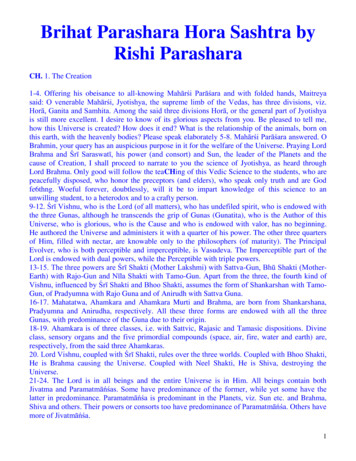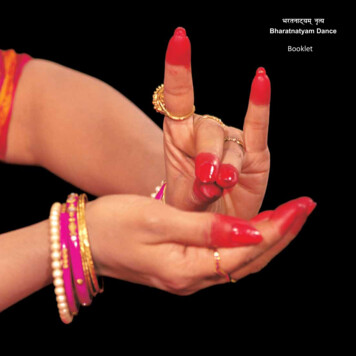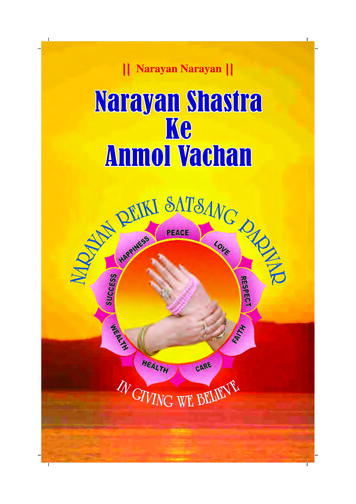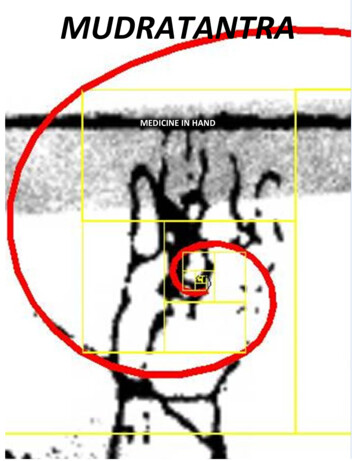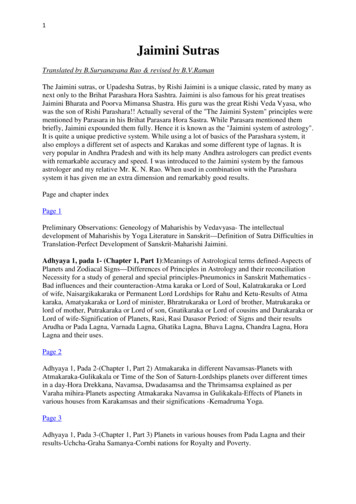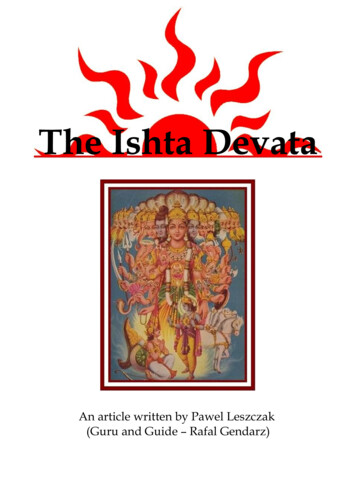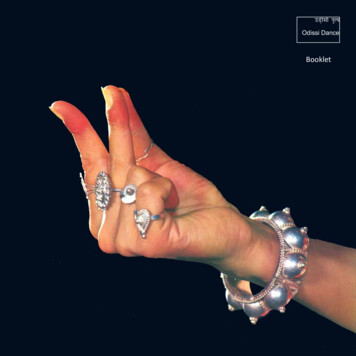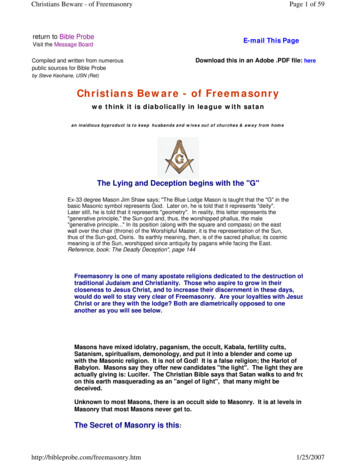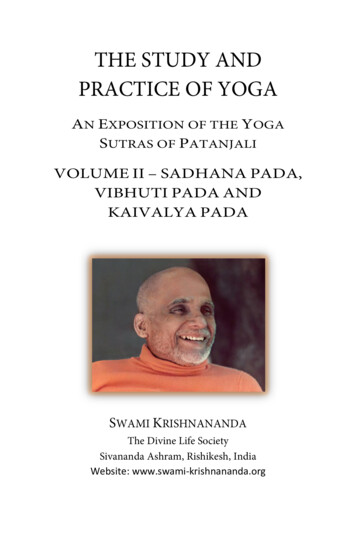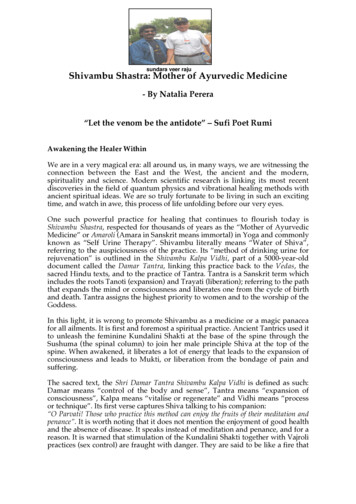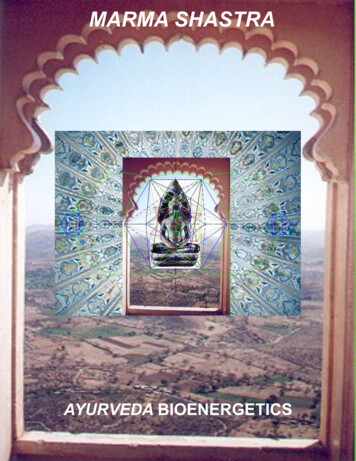
Transcription
MARMA SHASTRAAYURVEDA BIOENERGETICS
MARMA SHASTRAAyurveda Bio-EnergeticsWritten and Compiled by Michael James Hamilton, LACCopyright 2007; Michael James Hamilton, LAC2nd Edition Copyright 2011All rights reserved. Reproduction of any kind without prior written permission of the compiler is prohibited.MARMASHASTRA 2011 by Michael Hamilton, LAC. www.lotusspace.com
ACKNOWLEDGEMENTSI give gratitude to Dr. Suhas Kshirsagar and Dr. Thomas Yarema for their teachings; to mymother for her guidance; my readers for the hope to expand this knowledge; the ultimate realityfor always being there even when I do not always realize it.dew riseclouds fallrain washpain allMAHALOiMARMASHASTRA 2011 by Michael Hamilton, LAC. www.lotusspace.com
PREFACE TO THE MAIN WORKThis work presents the human bio-energy model (anthropocosm: cosmic human being) as profoundlyobserved in Ayurvedic medicine. According to ancient Vedic texts (and later through Tantric and Taoisttraditions), the energetic, or subtle, body is the foundation of the food, or coarse body, and the bridgebetween the physical and causal realms. Therefore, the structure of the subtle energetic body provides anintended means for human spiritual development, or evolution (which enables humanity to fulfill itspurpose as a conduit between heaven and earth, hence transforming into an entity more subtle, andoriginal).The text’s primary purpose is to present oriental bio-energetic theory, and second, to bridge theoreticalgaps between Traditional Chinese Medicine (TCM) and Ayurvedic Medicine, through the comparisons oftheir energetic structures, which are fundamental to the esoteric alchemical systems inherent within thetheories of exoteric medicine. Furthermore, the work intends to reveal even deeper realizations andcorrespondences of the origins of esoteric alchemical tradition (eg.Tantra, Taoist neidan). Even thoughthis work archives functions and indications of particular energy points (marma) in their pertaining tables,it will not serve as how-to-book on marma diagnosis and treatment.The energetic perspective of Ayurvedic Medicine differs to TCM (with Taoist Medicine on the deeperesoteric level) in terminology and approach (ie.theory and treatment), yet seem to naturally complementeach other. The mathematical expressions inherent in the cosmological structures of thesecomplementary traditions of alchemical medicine will reveal that they are not merely complementary, butoriginally one in the same. However, the observed differences between Ayurveda and TCM are probablydue to the varying Chinese interpretations of multiple Vedic texts (eg.Upanishads), which sometimesdiffer in perspective (eg.meridian flows). This work is one of the earliest to express these similarities anddifferences in an effort to establish a more complete system of understanding of ancient medicine. In amodern context, this work is yet another step contributing to the inevitable victory of the healingrevolution, which utilizes natural treatment in order to facilitate the balance and harmony of an energeticstructure inherent in all phenomena.As well as functioning as a compilation of metaphysics, the work is perhaps best used as a practical quickclinical reference. This book concisely and completely compiles information from commonly used textsources on channel theory and acupoints studied in acupuncture schools today, and organizes theinformation to be referenced quickly.It systematically summarizes bio-energetic theory through surveying its historical origins and presentingits integration into the oriental model of health. The oriental model of health will be presented by unfoldingcosmological structures inherent within the energetic structure of the human being, hence establishing theexistence of the juxtaposition between the human being (micro) and the cosmos (macro); theanthropocosm (purusha). Cosmic integrity is the cohesive interconnectedness of the three realms(ie.heaven, earth, humanity). The model of health is represented in humanity through the energeticstructure (ie.chakra, nadi, marma) of heaven, and the physical structure (ie.bones, marrow, blood,organs, semen, fat, muscle) of earth. The unfolding cosmology will reveal phenomenological bioenergetic structures, consisting of central pulsing energy voids (chakra), which spin energy (prana)through meridians (nadi), which can be balanced through the opening of their accumulation points(marma). The understanding of energy becomes essential to the effective practice of internal alchemy, orspiritual transformation (eg. yoga, qigong), because the disciplined understanding transforms the self bybecoming the bridge between the natural diligence of physical wellness and the devotion to awakeningthe spirit.The text is presented first with Ayurvedic terminology where applicable (because it is older), and thencomparatively is translated into the later Traditional Chinese Medicine (TCM) (which preserves theteachings and fills in the gaps through its consistently documented clinical development). Fundamentalbio-energetic theory (Vedic cosmology) is presented with Sanskrit terminology and linked through similarcomparison to Taoist cosmology (from Daozhan: Divination Resource for Daoist Calculation by Hamilton,2005). Thai Medicine (ie.massage), the spread and development of Ayurveda in Southeast Asia via theexpansion of Theraveda Buddhism, is referenced in order to definitively cross the gap from Ayurveda toiiMARMASHASTRA 2011 by Michael Hamilton, LAC. www.lotusspace.com
TCM, for meridian [Sanskrit: (nadi); Thai: (sen-sib)] data. The text surveys the original 107 marma points(translating into TCM point correlation, but may vary in size, function and indication, and treatment), andthen expands translation into the greater number of TCM acupoints (presented in Chinese pinyin; openingon meridians which correlate with the sen-sib lines); (borrowed from the meridian theory section of theAcusource: The Acupuncture Handbook, by Hamilton, 2000).The sources are referenced at the beginning of each section in tabular form and at the beginning of eachsubsection or where needed in parentheses. All figures are located at the end of the document andreferenced throughout. Quotations, Ayurvedic terminology in Sanskrit, all acupuncture medicalterminology, the names of classical Ayurvedic medical texts in Sanskrit, Vedic deities, and Chinesemedical texts that are in Pinyin (the presently used Chinese phonetic alphabetical language) or WadeGiles (older Chinese phonetic alphabetical system) are shown in italics. Names of people and places willnot be aoeiieouPINYIN PRONUNCIATIONSWade-Giles English Pronunciation (Example)afarpbelievets’, tzitschchimestdooreherffunkgohherieat or ‘i’ in red or ‘z’ in azures, ss, szsistershshinet’timeuyouvused in foreign words, national minority words andlocal dialectswsemi-vowel w/ ‘u’; no preceding consonants: wanthsshineysemi-vowel w/ ‘i’ or ‘u’; no preceding consonants:yests, tzZonechjumptiehowwayexperiencetoeiiiMARMASHASTRA 2011 by Michael Hamilton, LAC. www.lotusspace.com
TABLE OF CONTENTSPRELIMINARYACKNOWLEDGMENTSPREFACE iiTABLE OF CONTENTSiivMAIN WORKHISTORY AND TRADITION OF AYURVEDASOURCESORIGINS 3Hindu Mythology 3Prehistoric Antiquity 5Golden Age of Indian CultureMuslim Invasion 7European Trade 7Indian Nationalism 86TEXTS AND TRADITIONS 8Texts 8Medical Politics 13Physical Training 14Disciplined Spiritual Practice (Tantra)17FUNDAMENTAL THEORY: Vedic CosmologySOURCES123940MAGNIFICIENT VOID (SUNYA): Zero PointVedic Sunya 4141SINGULARITY POINT IN VOID: Nature of Absolute Reality (Parama-Shiva; Atattva)Anthropocosm 42Personality of Ultimate Reality (Parama-Shiva; Shiva-Shakti) 46DUALITY OF CAUSE AND EFFECT: Cycle of Cosmic Creation (Karma)Cause and Effect (Karma) 48Cyclic Existence (Samsara) 49Causal Singular Seed 51Effectual Multiplicity of Manifestation 52TRINITY WITHIN SELF: Process of Perception424754PENTOLOGY OF MATTER: Five Great Elements (Pancha Mahabhuta)Physical Objectivity 56Interrelationships 58Five Envelopes of Consciousness (Pancha Kosa) 59Toxicity of the Five Great Elements 6156SUBTLE ANATOMY (SUKSHMASHARIRA): Envelope of Energy (Prana kosa)GROSS ANATOMY (STHULASHARIRA): Envelope of Food (Anna kosa)Tri-Dosha Influence on Food Envelope (Anna kosa) 666666ivMARMASHASTRA 2011 by Michael Hamilton, LAC. www.lotusspace.com
Energy Transformation (Agni)Tissues and Wastes 69Channels of Flow 75Major Organs 76Auras and Luster 7768ENERGETIC THEORY: Subtle Anatomy of the AnthropocosmSOURCES:7980SUBTLE ANATOMY (Sukshmasharira)Envelope of Energy (Prana kosa) 8483WISDOM-POWER (PRANA-SHAKTI): The Power of Consciousness (Kundalini)Source of Primordial Power 84Central Channel (Sushumna nadi) 8584WHEELS OF ENERGY (CHAKRAS): Psycho-Energetic Knots in the Central ChannelENERGY MERIDIANS (NADI) AND POINTS (MARMA): Energy Matrix (Nadi Chakra)Major Vedic Meridians (Nadi) 99General Meridian Functions 108Meridian Count 108Meridian Types 109Meridian Classifications 110Meridian Relationships 113ENERGY POINTS (MARMA): Thresholds between Subtle (Prana) and Coarse (Anna)Historical Background of Lethal and Therapeutic Energy Points (Marma) 114Definitions 118Composition 119Symptom Type if Injured 119Regions and Locations 121Body Measurements for Point Location 123General Vedic Point Overview 126Meridian Point Classifications (Energetic Integrity) 153869911412 Regular Meridians: Flows and Points 1818 Spiritual Vessels: Flows and Points 282Non-Meridian Points 312APPENDICES333HISTORICAL BACKGROUND OF LETHAL AND ACUPUNCTURE MARMA335MARMA THERAPY 340MAPS AND FIGURESFIGURE KEYBIBLIOGRAPHYBIOGRAPHY345346459465vMARMASHASTRA 2011 by Michael Hamilton, LAC. www.lotusspace.com
viMARMASHASTRA 2011 by Michael Hamilton, LAC. www.lotusspace.com
HISTORY AND TRADITIONOF AYURVEDAMARMASHASTRA 2011 by Michael Hamilton, LAC. www.lotusspace.com
HISTORY AND TRADITION OF AYURVEDA (SCIENCE OF LIFE):SOURCES FOR HISTORYOrigins: (Sitchin), (Wilkins), (Svoboda), (Ros), (Kshirsagar), (Frawley), (Apfelbaum)Texts and Traditions: (Ros), (Feuerstein), (Svoboda), (Frawley)2MARMASHASTRA 2011 by Michael Hamilton, LAC. www.lotusspace.com
HISTORY AND TRADITION OF AYURVEDA (SCIENCE OF LIFE):Ayurveda translates as the “Science of Life.” Greater than a system of medicine, Ayurveda is astate of mind. Ayurveda is a living tradition which integrates with the consciousness of life, flowingfrom master to disciple. The ancient alchemical practice, utilizing preventative and palliativemedicine, has been documented to have been transmitted verbally in remote antiquity, prior tothe existence of its written word (2nd m.BCE).It is important to understand the chronology of the historical origins of Ayurveda, and the textswhich establish the Ayurveda tradition.ORIGINS: Sumerian Lore (Sitchin)It is important to realize that the oldest Hindu lore (ie.Vedas), consisting partially of medical verse,was brought into the Indus valley by Aryan invaders, who maintained the original Sumerianheritage.Hindu Mythology: Divine Authors of the Vedas; (Wilkins), (Sitchin)The Hindu pantheon of deities paralleled that of the Hittites who borrowed from the originalSumerian pantheon.Creation of the Primeval Flowing Ones (Rishis):According to the sources above, the early universe had only celestial bodies (Primeval Ones WhoFlow), the seven children of Mar-Ishi to become the Great Progenitors. When the gods, Demon(Rahu) and the Cut-off One (Ketu), attempted to ursurp a position amongst the gods, the Dragon(primeval planet) [Sumerian: Tiamat] was split in two by the Flowing One of Storms with a flamingweapon. The upper part of the destroyed planet (ie.asteroid belt, comets), the Dragon’s Head(Rahu), continuously traverses the heavens searching for vengeance. The lower part, theDragon’s Tail (Ketu), joined the Primeval Ones in their flowing orbits.Kash-Yapa: Lord of the Shiny Ones (Devas)The Vedic ruler of heaven, and progenitor of the Solar Dynasty, Mar-Ishi [Greek: Uranus], hadseven (or ten) children through his consort the Broad One (Prit-Hivi), personified Earth. One ofthe children, He of the Throne (Kash-Yapa) [Greek: Cronos] made himself lord of the Shiny Ones(Devas), seizing the title Sky Father (Dyaus-Pitar), the source of the Greek Zeus and RomanJupiter.After many ages, the gods of Heaven and Earth appeared. According to the Vedas, the gods,who originated in Heaven and descended to Earth, were a part of one family which had internalrivalries, usually motivated by laws of succession. The principle deities on Earth continued torepresent celestial bodies which played roles in the cosmic creation.Similar to Uranus (Zeus’s grandfather), Kash-Yapa spawned many gods, giants, and monsters(first Asuryas and later Adityas), some through his consort Boundless (Aditi), and others throughdiverse wives and concubines; but dynastic succession was only continued through his tenchildren by the Heavenly Mother (Prit-Hivi). Together Kash-Yapa, his consort Prit-Hivi, and his tenchildren formed the twelve Adityas, who all had celestial counter parts (ie.Sun, Moon, Mars,Mercury, Jupiter, Venus, Saturn). The initial seven included Vishnu, Varuna, Mitra, Rudra,Pushan, Tvashtri, and Indra. Later Agni was born, Bhaga (becoming the supreme Slavic godBogh), and finally Surya.Eventually, the leadership of the pantheon of twelve was passed on to the God of the HeavenlyExpanse (Varuna) [sim.Greek: Uranus]. Next, Indra, who slayed the Dragon, became the newLord of the Skies and God of Storms by slaying his father. Lightning and thunder were hisweapons, and his epithet was Lord of Hosts. However, he had to share the dominion with his twobrothers, Vivashvat, the progenitor of the first man (Manu), and Agni (“igniter”) who bequeathedfire to humanity.3MARMASHASTRA 2011 by Michael Hamilton, LAC. www.lotusspace.com
Chariots and Missiles:The Fashioner (Tvashtri), the artisan of the gods, provided celestial chariots, or aircraft (vimana),and hand-held missile weaponry to them. From fiery celestial metal he fashioned a discus forVishnu, a trident for Rudra, a fire weapon for Agni, a bolt of hurling thunder for Indra, and a flyingmace for Surya. Tvashtri’s assistants also provided other weaponry to the gods (ie. aerial net toIndra). Indra’s vimana had lights on its flanks, moved swifter than thought (speed of light?), andhad invisible, sun-eyed steeds, which emitted multicolored hues. Vimana have also beendescribed as being multitiered and submarine. The divine pilots (ashvins) of the golden aerialchariots were swift navigators who always traveled in at least pairs. The chariot used a tripartitedesign principle, having three levels, three seats, three support poles, and three rotating wheels(ie. for elevating, steering, acceleration).Sex and Violence:The Adityas selected the Three-Eyed (Rudra) to kill their grandfather, Dyaus for raping their sisterUshas. Dyaus retreated injured to a distant celestial body.Like the Iliad, the Ramayana is a tale of war with gods and men over beautiful heroines. The taleis about the abduction of prince Rama’s wife, Sita, by the king of Lanka (Ceylon). The monkeygod Hanuman, came to Rama’s aide, engaging in aerial battles with Kash-Yapa’s offspring, thewinged-god Garuda.Rivalry and War:Similar to the mythos of ancient Greece, the Vedic tradition describes a divine rivalry whicheventually led to war for the supremacy over the Earth and control over its resources (esp. cattle),between Kash-Yapa’s reigning younger offspring, the Adityas, and the resentful older Asuryas.The Asuryas [paralleling Near Eastern: Ashur, Asar, Osiris], eventually became connected withevil deities, or demons, of the Hindu traditions.The Earth produced food without cultivation before the war, which eventually caused famine. Therivaling gods sustained their immortality by drinking a celestial ambrosia (soma) mixed with cow’smilk, brought from Heaven to Earth by an eagle [Egyptian: bennu; Greek: phoenix; Chinese: Stepof Yu 9-1]. Cattle (kine) also provided sacrifices of roasted meat to the gods.According to the Satapatha Brahmana, the Adityas vanquished the Asuryas in the first war butwere defeated in the second war. Hence, the Asuryas divided the Earth amongst themselves.When the Adityas sent their elected leader Vishnu to plead for some of Earth’s resources, theAsuryas offered to give him as much as he could lie upon. But Vishnu outsmarted the Asuryas bybeing placed within an enclosure that could walk in three direction, thus regaining three quartersof the Earth regions. When the outsmarted Asuryas attacked from the south, the gods enclosedthem from three directions to support the strategy of Agni, who used a pinching maneuver fromthe north to vanquish them forever.According to the Mahabharata and the Rig Veda, the wars were fought in air, on land, and in thesea. The Asuryas created three aerial strongholds, cloud fortresses, and captured a city beneaththe sea, from which they launched their attacks against the Adityas. They also had invisible allieswho had invisible weapons. Indra slaughtered vast numbers of Asuyas, taking 99 landstrongholds, and pursued them hiding in their cloud fortresses from his aerial car.After defeating the Asuryas, Indra directed his efforts to freeing the kine, which were hidden bythe Asuryas inside a mountain, which was guarded by the Encircler (Vala). Assisted by theAgnirases, young gods who emitted divine flames, Indra smashed through the fortified hideawayand liberated the kine.Throughout the course of the wars (some texts say 1000 years), the Adityas elected three Chiefsof Office (Hotri). Agni was hotri when the wars began, Vishnu was hotri as they progressed, andIndra reigned supreme in the end. According to the Rig Veda, Indra ultimately accomplished thisby slaying his father, an action for which the gods excluded him from drinking the soma, thus4MARMASHASTRA 2011 by Michael Hamilton, LAC. www.lotusspace.com
threatening his immortality. When the gods abandoned Indra with the kine on Earth, Indrapursued them threatening to smite them with his thunder weapon. Fearing his weapon, the godsonce again agreed to share the soma with Indra.After seizing leadership, Indra was challenged by Tvashtri, the first born, for the throne’ssuccession. But Indra defended himself successfully, smiting Tvashtri with the Thunderer, thevery weapon created by Tvashtri for Indra. The struggle was succeeded by Tvashtri’s first born,the Obstructor (Vritra) (some sources refer to him as a quickly-growing gigantic-monster). In thebeginning, Indra was defeated, causing his retreat to remote territories of the Earth. After all thegods abandoned him, Indra only reengaged after being assisted by his loyal 21 Maruts, armedwith lightning and wearing golden helms, who piloted the fastest aircraft, which glowed red,roared in the winds, and projected beams of light. As all living things fled out of terror for thethundering approach of the Maruts and Indra, Vritra calmly awaited. After Vritra took initiative,spending all of his fiery missiles, Indra then took the offensive. When Indra’s thunderbolts (guidedmissiles) hit their target, Vritra fell helpless to the ground from his cloud tower, without hands orfeet. Then Indra vanquished him with a thunderbolt through between the shoulders. [sim. to thecontention of Horus and Seth]With Indra’s victory complete, he finally claimed the throne of his father Kash-Yapa, but doubtssurfaced concerning his true parenthood. The rumor stated that when Indra was hidden fromKash-Yapa as a child, his true father may have been his own brother, Tvashtri. According to theVedas, Indra ultimately shared his rule with Agni and Surya.Prehistoric Antiquity: Vedic Era; (Sitchin)Hurrians (Aryans): Preservers and Transmitters of Sumerian CultureThe Hurrians dominated the wide region between Sumer and Akkad in Mesopotamia, as well asthe Hittite kingdom in Anatolia, with their greatest cultural and trade center being situated inHarran, the crossroads of antiquity. Located on the upper Euphrates river on a land route (latercalled the Silk Road) that connected the Mediterranean Sea with the Far East, Harran wasconsidered a major religious center and crossroads for trade. Akkadian, being the internationallanguage of the ancient world (c.2000 BCE), was the predominant vehicle for cross culturalinfluences, thus scribes of the Hittite empire often substituted Sumerian and Babylonian words inHittite texts. It was the Hurrians who preserved Sumerian culture through incorporating the laterAkkadian elements into their own language, culture, and mythology, which was evident throughthe frequent usage of Sumerian divine names (ie.pantheon and divine abodes of the olden gods,which were actual Sumerian cities), epithets, and ideograms.Evidence suggests that the Hurrians, northern neighbors of Sumer and Akkad, intermingled withSumerians (esp.Ur) through mercantilism, particularly the garment industry, during the thirddynasty of Ur (c.3000 BCE). Later, the Hurrians retreated to the northeastern corner of theirterritory, where the established their new capital, Uratu (“Ararat”), where they worshiped apantheon headed by Tesheba [Hittite: Teshub], and their main shrine was called House of Anu(Bitanu).A treaty between the Hittite king Shuppilulima and the Mitanni (Hurrians) king Mattiwaza, whichcalled upon the gods as witnesses to ensure divine bliss, revealed that Hittite, as well as AryanHindu cosmology, mythology, and pantheons, were borrowed from the Hurrians [Old Testament:Horites (“free people”); Hittite: Hurri/Harri Ary (Aryans)], who maintained the original Sumerianpantheon.Emergence of Ancient Indus Valley Civilization (3000 BCE): (see Map 1) Harappans (3300-1700 BCE) built large cities (ie.Mohenjo Daro, Rakhighari, Dholavira) withwide, paved roads, aqueducts, public baths, and extensive waterworks, and traded withforeign lands via their sea port (Lothal); this has also been called the Sarasvati culture(Frawley) [sim.Sumerian: the Indus region was allotted to Ishtar; Gk: Hera]5MARMASHASTRA 2011 by Michael Hamilton, LAC. www.lotusspace.com
There is no firm evidence to support that the Harappans practiced medicine but they didpossess ingredients (ie.deer antler, bitumen) classical to Ayurveda medicine Decline: natural catastrophe; or more likely nomadic Aryan invasions from Central AsiaAryan Invasions (c.2000-1500 BCE): Insertion of the Vedas Aryans brought with them their ancient books of wisdom and sacrificial ritual (Vedas) (seebelow) (c.1200 BCE) The Aryans were Hurrians (of Harran), who closely interacted with and originally migratedfrom Ur (Sumeria) to Central Asia (c.3000 BCE)Golden Age of Indian Culture: Classical Era (6th c.BCE- 10th c.CE); (Ros); (see Map 4-5)Buddhism (c.500 BCE): Takshashila Gautama Buddha (563-483 BCE): the flourishing of Buddhism encouraged Emperor Ashokato establish medical debate centers (not formal institutions) at Takshashila (Taxila) [at thesources of the sacred Himalayan rivers (ie.Indus, Ganges); near modern Rawalpindi,Pakistan] Jivaka: product of Takshashila; royal physician of King Bimbisara of Magadha and appointedby the king to be health supervisor for Gautama Buddha and his disciples According to Chikitsa Vidya: Jivaka, considered a renowned Ayurvedic surgeon, and masteracupuncturist, was reputed “to have been born with an acupuncture needle in the right handand drug container in the left” [symbolic of inner and outer alchemy correlating withfire/masculine and water/feminine sides of the body] Final Examination at Takshashila: Jivaka’s final test was to find a plant void of medicinalvalue within a several mile radius; he passed when he returned empty hand; Ayurveda stillbelieves that nothing exists in the world that cannot be used as medicine Duties of the Royal Physician: Ayurveda was already politically accepted; health of the king isequal to the health of the state [sim.Chinese]o Protect from poisono Cure from wounds accidental or combato Ensure royal fertilityo Ensure queen’s safe pregnancy and deliveryo Ensure the healthy development of the royal progeny Physician of Gautama Buddha:o Gautama requests a purgativeo Buddha allowed his monks to receive Ayurveda therapy including surgery Fame:o Magadha population growth: citizens joined the Buddhist community solely to beavailable for Jivaka’s treatmento Consequently, the Buddha required wellness for discipleship Buddhism developed into a reaction against Vedic ritual which became polluted by impurebrahmans: Hindus responded to this with isolated violence against Buddhist temples andmonasteries, and widespread reform Spread of Buddhism into China: insertion of Ayurveda concepts into China leads to theestablishment of the Naturalist School (Yinyangjia) by its founder Zhou Yan (c.350-270 BCE)(Huard and Wong in their book, Chinese Medicine); (see Map 4-5) Alexander the Great (326 BCE) invades northern India: (see Map 6)It is likely that Ayurveda was known to Greece priorImpression: Alexander ordered all cases of poisoning to use AyurvedaReturned to Greece with Ayurvedic physicians on his retinue6MARMASHASTRA 2011 by Michael Hamilton, LAC. www.lotusspace.com
Emperor Ashoka (3rd c.BCE): (see Map 4) Convert of Buddhism: practiced compassion for all sentient beings Built charitable hospitals: including specialized surgical, obstetric and mental facilities forhumans and animals Sent Buddhist emissaries to foreign countries (260-218 BCE) (ie.Buddhist proselytism: SriLanka, Burma, Cambodia, Thailand, Laos, Athens, Antioch, Alexandria, Bactria, Tarim Basin;maintains condition of Ayurveda in India before Muslim invasions); (see Map 4) Milindapanha text (2nd c.BCE), a dialogue between King Milinda and the monk Nagasena,emphasized the principle of non-violence (ahimsa) through the explanation of unarmed selfdefense as one of the 19 monastic arts; such martial arts gained prominence when Buddhismexpanded into China, Southeast Asia, and Indonesia, where monks were not protected by theking Guptas and Mauryas Empires: (see Map 4)Employed and private physicians coexistVillage physicians are maintained by the government through gifts of land and salaryPlanted medicinal herb gardensEstablished hospitals and maternity homesPunished quacks who practiced without imperial permissionLiterary contributions of Vagbhatath Buddhist University (8 c.CE): Supported all forms of learning: Buddhism, Vedic lore, history, geography, Sanskrit literature,poetry, drama, grammar, phonetics, law, philosophy, astrology, astronomy, mathematics,commerce, war, and medicine Bodhidharma (from Kanchipuram) brings meditation and martial arts into China (6th c.CE) Nalanda (4th c.CE-12th c.CE) at Bihar:o International student bodyo According to two Chinese students: only 20% of all applicants could pass theentrance exams, instruction was free to all, senior students acted as teachingassistants, and teaching went on day and nighto Campus covered ½ square mile and housed as many as 10,000 pupils and 1500teachers, with numerous cooks and support staffo Nalanda Brothers: alumni network; some alumni elected to stay on as researchersMuslim Invasion: (Middle Ages: 10th-12th c.CE); (Ros) Slaughter of Buddhist monks as infidels Destruction of Buddhist universities and great medical libraries of Takshashila and Nalanda Nepal and Tibet: those who could escape, fled to Nepal and Tibet, where Ayurveda had firstpenetrated (8th c.CE); thus some Ayurvedic texts are preserved only in Tibetan translation Unani Tibbia: according to Persian texts (c.early CE: at the time when the Sassanian dynastydominated of northern India); system of Arabic medicine which combines Greek [Arabic:unani means “Greek”] medicine with Ayurveda; essentially rooted in Hurrian Ayurveda Mogul Emperor Akbar (c.16th CE): the enlightened ruler ordered the compilation of all Indianmedical knowledge; project was directed by his finance minister Raja Todar Mal Theraveda Buddhism was made a state religion in the Thai kingdom of Sukhothai (13th c.CE);(see Map 5)European Trade: (Ros) Coveted Indian spices: used to preserve meat and mask the taste and odor of putrefied meat7MARMASHASTRA 2011 by Michael Hamilton, LAC. www.lotusspace.com
Opening of secure eastern trade routes (c.16th and 17th CE): Steady flow of spices European fascination for India Sake Deen Mohammed (aka.”Brighton Shampooing Surgeon”) (18th-19th CE): Coined the word “shampoo”: [Hindi: massage (champana) morphed into English “shampoo”] Indian Vapor Bath and Art of Shampooing: many Lords and ladies received treatment andpreventative care; and wrote odes to his expertise Portuguese bring syphilis to India: Bhavaprakasha (16th c.CE): first text to describe syphilis as “the foreigner’s disease” Intellectual bigotry: Sir Praphulla Chandra Ray in his History of Hindu Chemistry sites an essay by a Briton inwhich the author endeavored to prove that Sanskrit was a Brahman forgery modeledfrom Greek after Alexander’s conquest Lord Macaulay (1835): ordered the exclusive encouragement of European knowledgeover indigenous in all areas governed by the East India Companyo Western medicine is recognized as legitimate, while the Eastern systems arediscouraged (before 1835, Western and Indian physicians exchanged knowledge)o Vast quantities of indigenous expertise evaporated due to the suppression ofinstructionth Continuance of Ayurveda contributions to modern medicine (19 c.CE): plastic surgery German translation of Sushruta treatise: details an operation for nose and ear repair Now appears in modern textbooks as the pedicle graft, which led to the development ofplastic surgery; plastic surgeons consider Sushruta as the father of their craft Ayurvedic surgeons performed skin grafting, and operations for cataract and
ii PREFACE TO THE MAIN WORK . This work presents the human bio-energy model (anthropocosm: cosmic human being) as profoundly observed in Ayurvedic medicine.According to ancient Vedic texts (and later through Tantric and Taoist traditions), the energetic, or subtle, body is the foundation of the food, or coarse body, and the bridge
